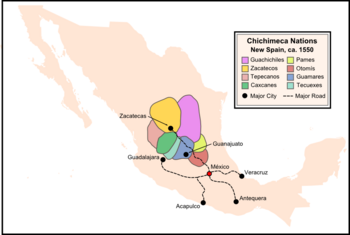Guachichil language

Map of Chichimeca Nations
Guachichile territory in purple. |
|
| Total population | |
|---|---|
| (Unknown) | |
| Regions with significant populations | |
|
Central Mexico (e.g. Zacatecas, Guanajuato, San Luis Potosí) |
|
| Languages | |
| Guachichil, Spanish | |
| Religion | |
| Roman Catholic | |
| Related ethnic groups | |
| Other Chichimecas |
| Cuachichil | |
|---|---|
| Region | Zacatecas |
| Extinct | (date missing) |
|
unclassified (Corachol?)
|
|
| Language codes | |
| ISO 639-3 |
None (mis) |
0w6 |
|
| Glottolog | None |
The Guachichil, Cuauchichil, or Quauhchichitl, were an Indigenous peoples that occupied the most extensive territory of all the indigenous Chichimeca Nations tribes in pre-Columbian Central Mexico.
The Guachichiles roamed through a large region of Zacatecas; as well as portions of San Luis Potosí, Guanajuato, and northeastern Jalisco; south to the northern corners of Michoacán; and north to Saltillo in Coahuila.
Considered both warlike and brave, the Guachichiles played a major role in provoking the other Chichimeca tribes to resist the Spanish settlement. The historian Philip Wayne Powell wrote:
These warriors were known to fight fiercely even if mortally wounded and were a key component in the Spanish defeat during the Chichimeca Wars. The children learned to use the bow at walking age and the hunters were such good shots that if they missed the eye and hit the eyebrow they would be extremely disappointed. The Chichimeca bow and arrow was expertly crafted allowing for penetration of Spanish armor.
Two Spanish accounts of the Chichimeca’s archery skill: "On one occasion I saw them throw an orange into the air, and they shot into it so many arrows that, having held it in the air for much time, it finally fell in minute pieces” (Powell 48). “One of don Alonso de Castilla’s soldiers had an arrow pass through the head of his horse, including a crownpiece of double buckskin and metal, and into his chest, so he fell with the horse dead on the ground ‘this was seen by many who are still living’ (Powell 48).
The Chichimeca were nomadic making them very mobile and experts of the rough vegetation filled (mostly cactus) land in which they always looked for hiding spots. “His long use of the food native to the Gran Chichimeca gave him far greater mobility than the sedentary invader, who was tied to domesticated livestock, agriculture, and imported supplies. The nomad could and did cut off these supplies, destroy the livestock, and thus paralyze the economic and military vitality of the invaders; this was seldom possible in reverse” (Powell 44). They attacked in small groups ranging from five to be two hundred braves.
...
Wikipedia
